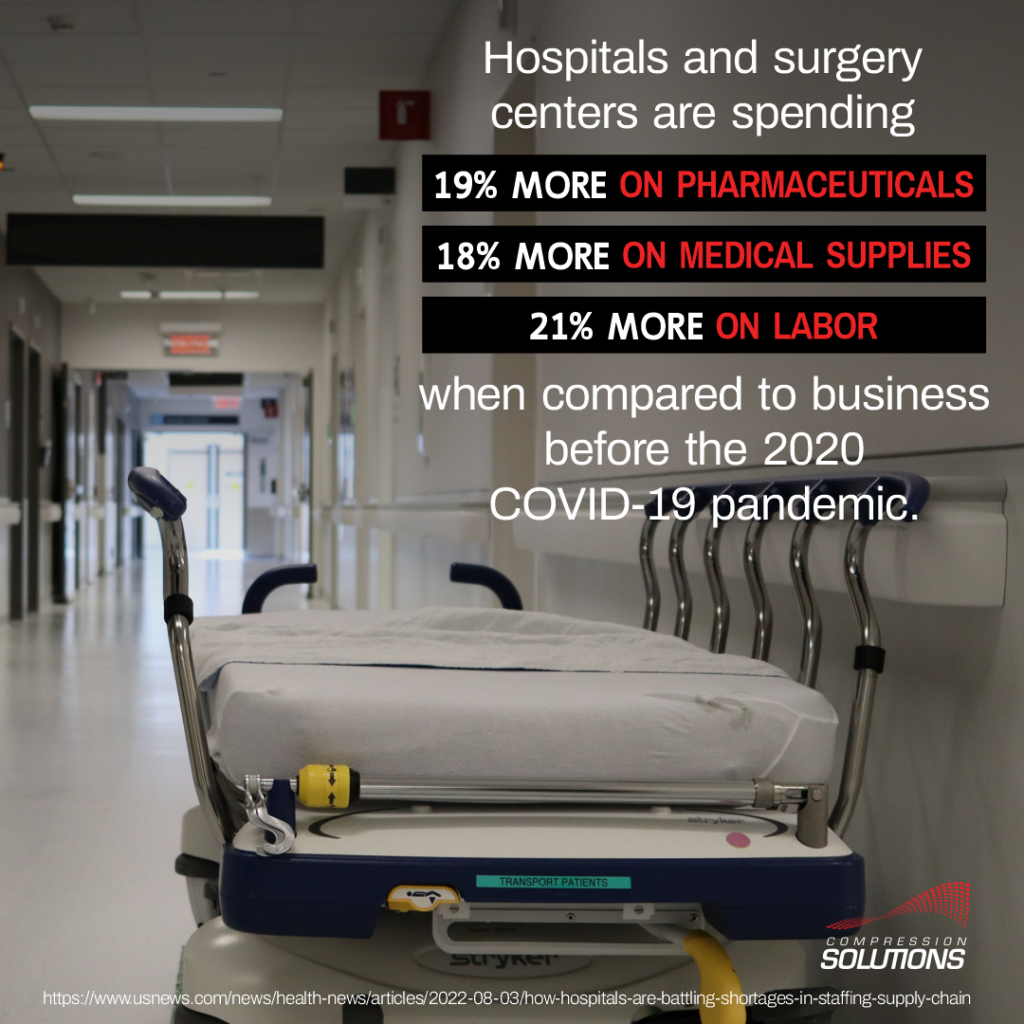Supply chain issues are affecting all industries and healthcare is no stranger to this problem. But shortages of necessary equipment in hospitals and surgery centers can be life threatening, especially items used during surgeries or trauma-care. But supply chain just scrapes the surface, there are many issues facing healthcare systems that administrators are trying to solve.

After taking a hit from the COVID-19 pandemic with a focus of fighting a highly infectious virus along with canceling elected procedures, and staffing shortages, health systems continue to suffer. There is an increase in pressure to keep budgets down, perform more procedures, along with supply chain issues that are plaguing healthcare units.
These crises come at an odd time where technology is rapidly changing and more surgeons are relying on robotics, augmented reality, and other tools that are costly to hospitals.
Supply Chain & Looming Shortages
One major concern plaguing hospitals around the country: a looming tourniquet shortage. Large healthcare conglomerates such as Stryker and Zimmer Biomet supply this life-saving device to facilities. However, due to the supply chain crisis, big healthcare companies are struggling to stock tourniquets which are necessary.
This is causing healthcare systems to get creative and identify creative solutions for backlogged supplies. One workaround is a product developed by Israeli-startup HemaClear. HemaClear has developed a sterile surgical tourniquet that is designed with superior exsanguination, a large sterile surgical field, and it can block arterial blood re-entry.
This product is manufactured in Israel and the United States and is not facing the supply chain shortages that many larger medical providers are trying to solve. Along with the ability to stock this product, HemaClear boasts additional benefits of using their sterile tourniquet system including the ease of use and reduced risk of postoperative side effects.
Click here for a clinical study featuring HemaClear.
While the supply chain problems are causing several problems for healthcare units, there is no sign of resolution in the future. Air-freight warehouses are jammed just as many containers sit outside of ports without the ability to unload. While some of this was sparked by pandemic and social distancing, the problem worsened after conflict in the Ukraine erupted.
Here is a prediction from Wired on how the supply chain crisis will worsen over the coming months.
What does this mean for hospitals and surgery centers? It’s time to think outside of the box when it comes to medical supplies. Sometimes the supplier or product that has always been reliable, may not be the best option during this ongoing crisis.
This is why it’s important to partner with device representatives who understand the current landscape and will help create solutions.
Staffing Shortages
It’s estimated that 1.5 million healthcare jobs were lost when the COVID-19 pandemic hit the United States. While emergency rooms and infectious disease units struggled for the help and support needed, elected surgeries and visits to doctors stopped, which led to layoffs. And while things may be running as normal now, many did not return back to the workforce.
There is predicted to be a 1.1 million nurse shortage by the end of 2022, according to the American Hospital Association. And, this isn’t just a nursing shortage, office staff, lab techs, and other positions are feeling the weight of staffing shortages.
The result of staffing shortages is simple: patients are feeling the pressure. Some are not getting access to vital care, others are having to wait long periods of time before surgeries. Hospital staff across the country are feeling the pressure of lack of help and are facing burnout and low morale at work.
While there is no simple solution to the detrimental staffing shortages facing health systems, many are trying to implement more efficient systems in order to reduce the amount of work office workers have to take on, others are implementing more robotics in order to try and make surgeries faster.
PRO-MAPP is a digital solution that many hospitals or surgery centers are taking advantage of to lift some burden off of office staff. This software is easy to use and allows for faster patient check-in, reduces time from service to billing, and eliminates post-operative dictation. Check out a case study about how one surgeon replaced two office workers after implementing this software.
Backlogs of Procedures
As mentioned previously with staffing shortages in hospitals, many elective surgeries were postponed, or even canceled to reduce COVID-19 spread and exposure. The Mckinsey Group published a study on the backlog of procedures and the after effects of postponing surgeries.
It’s estimated that across the United States hospitals suffered $22.3 billion in financial losses between March through June of 2020. While hospitals have been working to perform the surgeries that were delayed due to the pandemic, the effects of the shutdown continue to affect hospitals and surgery centers.
Opioid Epidemic
As if it’s not difficult to navigate an abundance of surgeries that need to be scheduled coupled with inventory and staffing problems, health units continue to receive scrutiny due to the opioid epidemic.
Opioids are prescribed for a variety of reasons including post-surgical recovery, chronic pain, and injury. Of those prescribed 1 in 15 patients will develop an addiction. And, overdose deaths are the leading cause of accidental deaths in the United States.
Some doctors are seeing benefits in managing acute pain as opposed to treating pain after a procedure. By prescribing a pain pump, patients can receive a steady amount of pain medication without being prescribed an opioid.
Learn more about treating acute pain here.
Many hospitals are updating their pain management policies in order to prescribe less opioids which is why multimodal pain management is becoming a more used method.
Pressure to Adopt New, Expensive Technology
Along with several challenges that face health systems, there is continuous pressure to adopt new and expensive technology. The pandemic created a massive demand for streamlined technology with the issue of backlogged cases. But also, patients are now requesting robotics in the operating room in hopes for more accurate, and less invasive procedures.
Investing in robotics is expensive, which is a barrier for some hospitals or surgery centers. But, this technology advancement has been long in the making before the pandemic. In fact, from January 2012 to June 2018, robotics used in surgery increased 8.4%.
This type of new technology is taking pressure and stress off of doctors and some patients find recovery easier when the surgery was assisted by robotics. However, items like cost and security can be a concern when investing in robotics.
However, there small changes surgery centers can make that lead to big budget cuts. In turn, this can lead to extra budget to invest in robotics. Learn more here.
Get ambIT for Your Facility
Equip your hospital or surgery center with ambIT pain pump devices, including convenient medical billing and customer support when you order through Compression Solutions.
